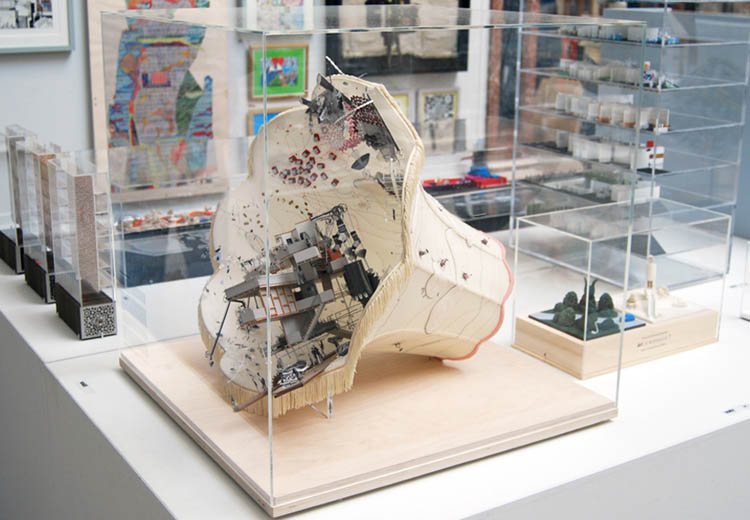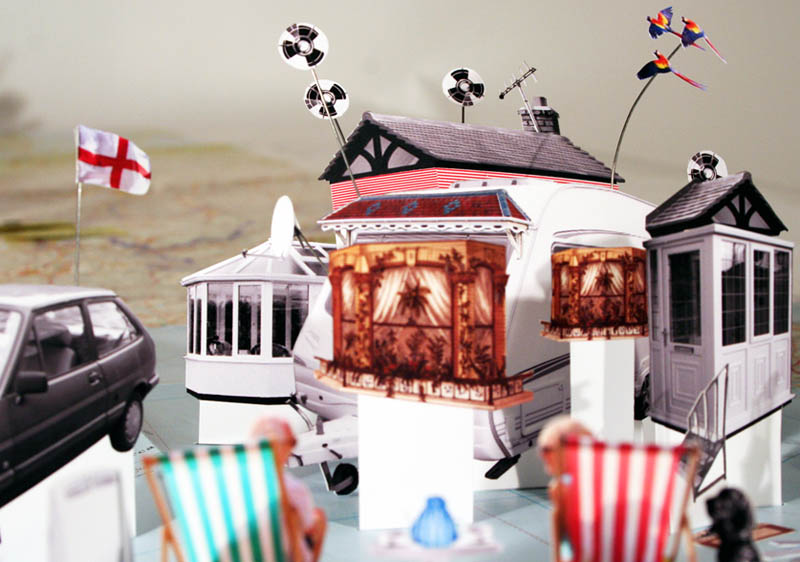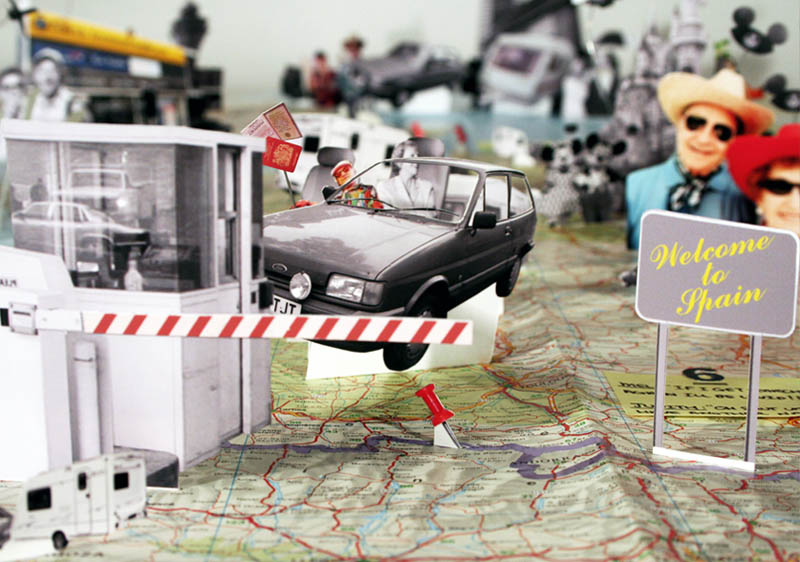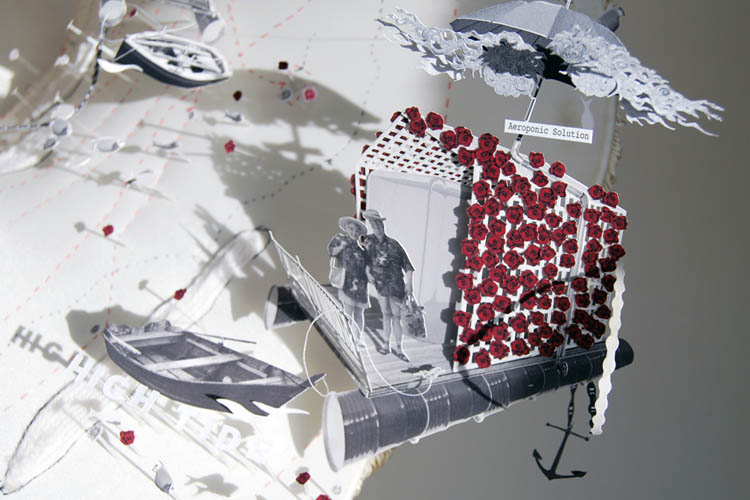The Migration of Mel and Judith
 [Image: From "The Migration of Mel and Judith" by Thomas Hillier].
[Image: From "The Migration of Mel and Judith" by Thomas Hillier].Thomas Hillier, of Emperor's Castle fame, has sent in a newly documented but chronologically older project of his called "The Migration of Mel and Judith."
"The Migration of Mel and Judith," Hillier writes, "was the pre-cursor to The Emperor’s Castle and my first real exploration into using narrative as the vehicle for generating and scrutinizing my architectural ideas. It was also where I began using craft-based techniques and 2/3-dimensional assemblage to illustrate the design process."
The Migration, though, is not only an entire storyline packaged inside a beautifully realized, miniature architectural world—it's also told inside a lampshade.

 [Images: From "The Migration of Mel and Judith" by Thomas Hillier].
[Images: From "The Migration of Mel and Judith" by Thomas Hillier]. Mel and Judith, Hillier explains, are "a recently retired couple from Croydon who have decided to give up on their life in London’s third City and travel Europe," looking for a place to touch down for a while (and for better weather).

 [Images: From "The Migration of Mel and Judith" by Thomas Hillier].
[Images: From "The Migration of Mel and Judith" by Thomas Hillier]. Soon enough, though, they get homesick—and the architectural transformation of their caravan-home begins:
- To combat thier longing they slowly adapt and customise their caravan-house to feel a little more like home. Walls of the caravan become aroma filled bricks of white bread, especially made by Mel & Judith themselves. Other adaptations include the pebbledash façade reminiscent of their Croydon abode. A green lawn-carpet that is much cooler underfoot than the hot Marbella sand and when it gets too hot there's always the sprinkler system and snow-chimney.




 [Images: From "The Migration of Mel and Judith" by Thomas Hillier].
[Images: From "The Migration of Mel and Judith" by Thomas Hillier].This, too, steeped in English nostalgia, becomes too staid for them, and the couple decides to leave Europe altogether, alighting for the more exotic climes of Luxor, Egypt.
 [Image: From "The Migration of Mel and Judith" by Thomas Hillier].
[Image: From "The Migration of Mel and Judith" by Thomas Hillier]. There, they settle "on a small, uninhabited island situated on the River Nile, where in their weird and wonderful ‘Do-It-Yourself’ English manor Mel brews beer in his bathtub-brewery whilst Judith bakes rose-bread in the bread-garden."
- Their island comes alive during the holiday season creating an English retreat in the middle of Luxor, a retreat that lures in English tourists with the opportunity to be surrounded by the sights, sounds and smells of home. The smell of roses and freshly baked bread drift through the air whilst the temptation to drink beer (which is illegal in Luxor) is impossible to resist.













 [Images: From "The Migration of Mel and Judith" by Thomas Hillier].
[Images: From "The Migration of Mel and Judith" by Thomas Hillier].If you pull back, though, and look at the whole project within its physical and visual frame, the self-enclosed curling world of the lampshade adds a wonderfully anti-perspectival, frilly concavity to the couple's journey. These latter scenes become both explosive and disorienting.
Like the spaceships in Stanley Kubrick's film 2001, the walls of their representational frame simply turn and turn, bringing us over and over again back through the same space, as if unwilling to let go of what's come before. Here, that space is asprawl with tidal flats and marshlands, fishing spots and coves. The couple, living now in Luxor, welcome visitors, dry their clothes aboard the boat deck, catch some afternoon sunlight, and grow old together, retired into this deliberately over-nostalgic world of their own making, constantly cycling back in memory through their shared past.
They have built a frame to fit themselves within, as if to give their lives narrative completion.


 [Images: From "The Migration of Mel and Judith" by Thomas Hillier].
[Images: From "The Migration of Mel and Judith" by Thomas Hillier].Check out The Emperor's Castle, meanwhile, if you haven't seen it already, and then click through to Hillier's website.





Comments are moderated.
If it's not spam, it will appear here shortly!
Love the way Thomas Hillier presented this. Just wonder, other than labelled as 'craft base presentation' is there any other specific name for this kind of presentation. I have seen Prof CJ Lim from Bartlett did slightly same technique for SKY city.
my mind just exploded! magnificent! your work wonkas me!
In a way this work reminds me of the "Hypnerotomachia Poliphili", Italian novel published in 1499, in which the story or the "travelogue" of a couple in love is rendered in fine and detailed etchings, always depicting bodies in detailed classical architectures.
http://en.wikipedia.org/wiki/Hypnerotomachia_Poliphili
I love it! It's so charmingly intricate.
What do you have planned for tomorrow's post?
An Outfit For Every Season
LOVE this work. Brilliant!! Liz Swanson, University of Kentucky
This is awesome! I love the details of it all.
Post a Comment